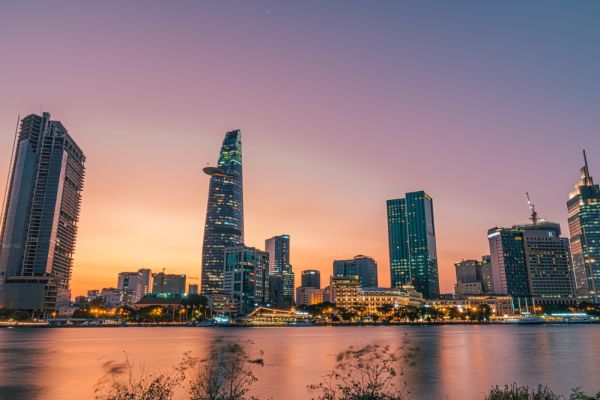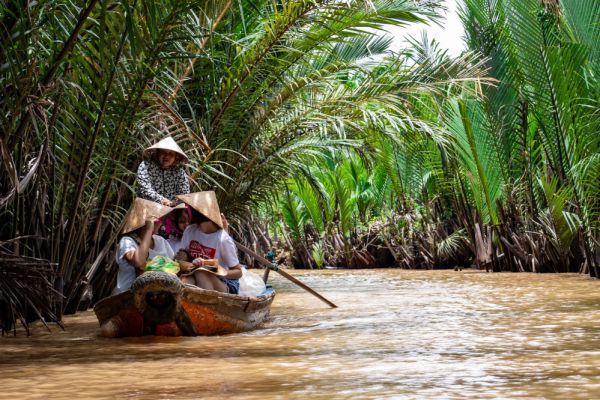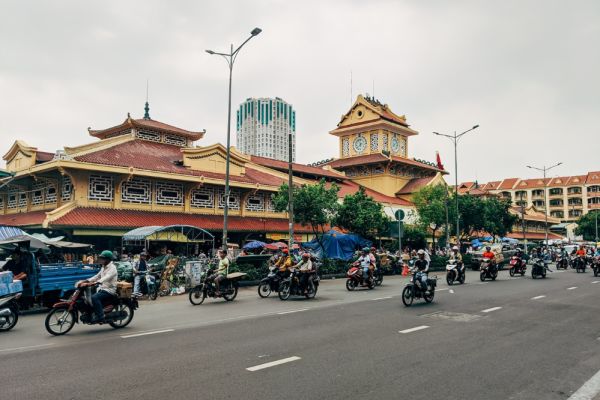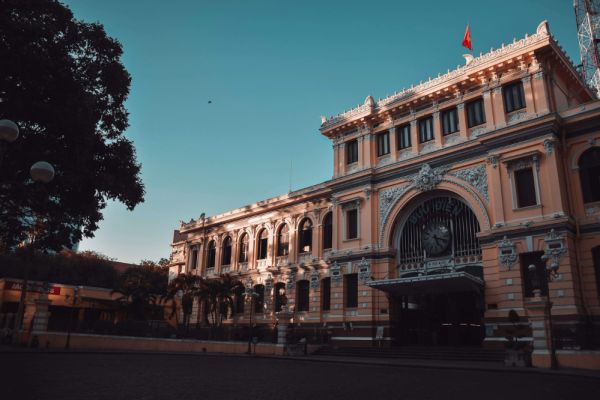Ho Chi MinhTravel Guide
Once known as Saigon, Ho Chi Minh City is Vietnam’s southern powerhouse, filled with energy, innovation and a respectful nod to the past. Visit Notre Dame Cathedral (with all materials imported from France), the iconic Central Post Office and if you love your history, the War Remnants Museum will captivate you. If you’ve come to Vietnam to experience the culture, start with the food. Ho Chi Minh City has 5-star street food with a tasty mix of regional varieties. There are also temples to explore, fantastic shopping, day spas and of course, the warm and friendly Vietnamese people.If you’re planning a visit, explore our Ho Chi Minh City travel guide. We’ve collected the best tips from our travel experts, and have top suggestions for things to do, the best time to travel, where to stay in Ho Chi Minh City, getting around and more.
Ho Chi Minh quick facts
Language
National language
Vietnamese
Beverages
Bottle of Coke/Pepsi (330ml)
CAD $0.65
Local time
Monday
3:50am
Currency
Vietnamese dong
CAD $1.00 = VND ₫19075.98
Eating out
Restaurant meal (casual dining)
CAD $2.62
Electricity
Plug type: A
2 or 3 pins • 220V
Explore Ho Chi Minh
Where to stay in Ho Chi Minh?
When considering where to stay in Ho Chi Minh, you'll need to think about your budget and the kind of experiences you want to have. If you want to stay somewhere that doesn't break the bank but doesn't cost you sleepless nights, hotels near Ben Thanh will likely be your best bet. Meanwhile, if you want easy access to landmarks, restaurants and shopping centres, stay at Nguyen Hue Boulevard.Here are some recommendations for the best areas to stay in Ho Chi Minh.
Also known as District 1, Ho Chi Minh's City Centre is the place to be for dining, shopping, and sightseeing. Here you'll find must-see landmarks such as the Central Post Office, Jade Emperor Pagoda, and the Notre-Dame Basilica. You'll also find a wide range of accommodation here, from five-star hotels to budget-friendly hostels.
The largest Chinatown in Vietnam, Cholon is one of the best places to stay in Ho Chi Minh if you're looking for budget-friendly accommodation. It's also close to Buddhist temples and the Binh Tay Market, the largest in Vietnam. Hire a cyclo (a bicycle with passenger seating in front) to take you around the area to check out the architecture and the authentic Chinese eateries.
Staying near the Ben Thanh Market allows you easy access to local handicrafts, affordable clothes, yummy food, and Vietnamese art. The market is one of the oldest landmarks in Ho Chi Minh and it opens early and stays open until late. Stay in a budget-friendly hostel or a more luxurious hotel nearby.
The oldest and widest street in Ho Chi Minh, Nguyen Hue Boulevard has played a significant role in the country's history. During the Vietnam War, foreign correspondents stayed in the hotels along this street. On one end of the street, you'll find the City Hall and on the other, Saigon River. Along this pedestrian-friendly area, there are a lot of bars, cafes, and interesting buildings to check out.
If you want to experience the bustling nightlife of Ho Chi Minh, stay at Pham Ngu Lao. This area is made up of two parallel streets and is known as the backpacker district of the city. If you stay at one of the many budget-friendly hotels nearby, you'll find street food vendors selling delicious eats at all hours.
Originally called rue Catinat, Dong Khoi Street underwent many name changes. However, its beautiful French Colonial buildings remain. If you stay here, you'll be within walking distance of designer boutiques, art galleries, and vibrant cafes. If you stroll along the Dong Khoi, you'll find yourself near the Opera House and other Ho Chi Minh attractions.
Believe us when we say, this is just the start. Book your Ho Chi Minh accommodation today!
Things to do in Ho Chi Minh
Whether you're into history, culture, shopping or food, there are plenty of things to do in Ho Chi Minh. Vietnam's largest city has street food stalls and fine-dining restaurants, museums and markets, parks and gardens. You can explore all of these things and more when you book a Ho Chi Minh holiday.
Take a day trip to visit the Mekong Delta, Vietnam's agricultural heartland. You'll explore the region by boat and see what everyday life is like for the farmers who produce rice and tropical fruit. Plus, you can enjoy fresh Vietnamese food at a local restaurant or from a boat-rowing vendor.
From the outside, the Reunification Palace looks like a time capsule from the ‘60s and ‘70s. However, it's actually an important Ho Chi Minh landmark. This was where the presidents of South Vietnam lived until the end of the Vietnam War, and where the North and South reunited into one Vietnam. It's a must-see for anyone interested in history.
The Basilica of Our Lady of the Immaculate Conception is better known as the Saigon Notre-Dame Cathedral. This red Romanesque building was built by the French in the mid-1800s, and is one place you should definitely have on your itinerary when you visit Ho Chi Minh. Worshippers attend mass regularly and some locals believe that a statue of Mary here shed tears in 2005.
One of the most beautiful places in Ho Chi Minh is also one of its most functional. Constructed in the late 1800s, the Central Post Office was designed by Gustave Eiffel (who also engineered his namesake tower in Paris). It's still being used as a post office today, so be sure to send a letter or a postcard from here during your visit.
Ho Chi Minh was a Vietnamese Communist revolutionary leader who played a key role in the country's history. Because of this, they renamed the city (previously Saigon) after him in 1975. You can find out more about him by visiting the Ho Chi Minh Museum; it's located inside Dragon Wharf, the former customs house that combines French and Vietnamese styles.
Apart from its struggles for independence, Vietnam has a rich history that can be traced back to the prehistoric period. You can learn more about this by going to the Museum of Vietnamese History; find it inside the grounds of the Botanic Gardens. Go on a guided tour to find out more about the cultural evolution of Vietnam.
Did you know that Vietnam has a medical tradition that spans thousands of years? You can learn more about this in the Museum of Traditional Vietnamese Medicine, also known as the FITO Museum. It houses ingredients, scrolls, and other artefacts that practitioners used to cure illnesses and promote the wellbeing of their patients.
An underground system of more 120km, the Cu Chi Tunnels were originally used by Vietnamese soldiers during their various wars. Today, they form part of a war museum that gives visitors a glimpse of what life was like for soldiers. You can crawl around sections of the tunnels, taste the food that the fighters would have eaten, and even fire an M16 rifle.
Built in 1909 by the Chinese community, the Jade Emperor Pagoda is one of the most important shrines in Ho Chi Minh, and a must-visit if you want to learn more about Taoism. The Jade Emperor is a major figure in Taoist theology, and this spectacular temple built in his honour is beautifully decorated with statues and elaborate carvings. The locals still use it to this day.
Before you leave Ho Chi Minh, be sure to pay a visit to Phuoc An Hoi Quan Pagoda. Here, locals make offerings to a life-sized figure of a sacred horse before departing on a journey. This small Taoist temple has intricate ornamentation and is also home to brass ritual items and weapons.
Vietnam's struggle for independence and unification has not been without bloodshed. The War Remnants Museum is a sobering reminder of the country's wars with the French and the Americans. There are weapons, photographs, dioramas, and other artefacts such as a guillotine. The museum has been running since 1975 and is one of the most visited museums in the country.
To see great examples of Vietnamese arts and culture, visit the Fine Arts Museum. It's housed in a French Colonial mansion that once belonged to the richest man in Saigon. The museum's collection includes oil, silk, and lacquer paintings as well as ceramics and sculptures. Relics from the 7th to 17th centuries are also exhibited in this museum.
The HCMC museum is dedicated to Ho Chi Minh City, housed in an elegant, Neoclassical building built in 1885 and formerly known as the Gia Long Palace. It takes visitors on a journey of the city's history through archaeological relics, old city maps, and ceramics. The Vietnamese revolution against the French as well as images from the Vietnam War are also displayed on the upper floor of the museum.
If you want to see contemporary Vietnamese art, the San Art gallery is for you. This not-for-profit organisation was initiated by artists to exchange knowledge and showcase their work. You can see musical pieces, poetry, and installations as well as contemporary visual art. They also have an excellent reading room with a wide selection of art books.
Looking for an immersive experience? Then a Ho Chi Minh tour is the way to go.
Ho Chi Minh travel tips
The following Ho Chi Minh travel tips can help you navigate your way around Vietnam's largest city. When in Ho Chi Minh, it’s recommended you get a prepaid SIM card from a convenience store so you can access affordable 3G data. This will then allow you to use your mobile's maps and contact emergency services by dialling 113.You should also note that the tap water isn't drinkable, so buy bottled water from convenience stores or supermarkets to stay hydrated.Here's some more Ho Chi Minh travel advice for you to keep in mind.
There are two ways for Australian passport holders to get a Vietnam visa. You can send your passport and a completed application form to the Vietnamese embassy and have them returned to you by mail. Alternatively, you can apply online to have a visa stamped upon your arrival at the Vietnam airport. This is only a guide, so if you want the most accurate information, please visit the Vietnam Embassy website.
Street food is an important part of Ho Chi Minh's food culture. Vendors offer pho (rice noodles in broth), banh mi (baguette sandwich), and many more specialities. Be sure that the stalls are clean and that a lot of locals are eating there for the safest and tastiest food experience.
The voltage in Ho Chi Minh is usually 220V, and very rarely 110V. Either way, it's different from Australia's 240V. So you may need to have a converter as well as a universal adapter for your electronics when you visit. Most accommodation will have a two-pin or three-pin plug with flat prongs. However, there are some with plugs for round prongs.
Tan Son Nhat International is the name of Ho Chi Minh's airport, located just 6km north of the city centre. Its Terminal 1 is for domestic flights while its Terminal 2 is for international arrivals and departures. You can get a taxi from the main queue or from pre-paid taxi counters after clearing customs. There are also car rental services available.
Vietnam's currency is the dong. You'll need to have banknotes on hand during your holiday as most retailers don't accept coins anymore. These you can withdraw from most ATMs; look for the corresponding symbols on your debit or credit card. You can also pay with your credit card, but only at big hotels and restaurants in Ho Chi Minh. To exchange currency before you go, head to your nearest Travel money Oz outlet.
While it's not mandatory, tipping in Ho Chi Minh is much appreciated by your servers. Hotel housekeepers, restaurant wait staff, massage therapists and tour guides all earn low wages. So be sure to show your gratitude with a small token when they provide you with excellent service.
When visiting Vietnam, it's best to know some basic phrases such as hello (xin chao) and thank you (xin cam on). If you're staying at District 1 and other areas of Ho Chi Minh that tourists frequent, you'll encounter locals who speak English. If you stray off the beaten path, you might find elders who speak some French.
Flights to Ho Chi Minh
Ho Chi Minh food and drink
If there's one word to describe Ho Chi Minh's food and drink scene, it would be vibrant. From traditional Vietnamese cuisine to modern fusion dishes, you'll enjoy fresh ingredients, a variety of textures, and well-balanced flavours. Eat at a street food stall or indulge in a fine-dining establishment. Drink a morning cup of Vietnamese coffee or a fresh beer in the evening. From Pham Ngu Lao Street to the Binh Dien Seafood Market, wherever you go, you'll find Ho Chi Minh dishes and drinks to suit your palate.
Plan to wake up early one day to hit Ho Chi Minh's lively food markets: Binh Tay in Chinatown, Ben Thanh in District 1, and Binh Dien Seafood Market in District 8. Stop by stalls selling pho and goi cuon (traditional spring rolls) for a hearty breakfast. Then, shop for fresh produce and fashion items with less of a crowd. Afterwards, enjoy Ho Chi Minh's street food from the hawkers at the food court.
For a budget-friendly night out, enjoy Vietnam's incredibly cheap bia hoi draft beer while sitting on plastic chairs in front of a local bar. For a more upscale experience, head to the roof decks of Ho Chi Minh's famous hotels for cocktails. Hit the clubs for live music and then enjoy barbecued meat at a street food stall afterwards.
Delicious as it may be, Ho Chi Minh dining isn't limited to Vietnamese cuisine. There are Indian, Italian, Chinese, and Thai eateries all over the city. Be sure to visit Pham Ngu Lao Street as it caters to all kinds of tastes. Indulge your senses at District 1, where you'll find several excellent French fine-dining restaurants.
Vietnamese coffee is an obsession among its people. It's usually made by pouring hot water over rough ground beans inside a metal drip filter (a Phin filter). This creates a strong brew that's often sweetened with condensed milk. You can enjoy it hot or iced from cafes or Ho Chi Minh street food vendors.
Get a real taste for the local cuisine by booking a Ho Chi Minh tour.
Where to shop in Ho Chi Minh?
From bargaining with street vendors to purchasing designer items at high-end boutiques, a variety of Ho Chi Minh shopping experiences are on offer for you to enjoy. You'll need at least a few hours for the best retail therapy session, though! Start your morning by visiting one of the city's open-air markets for fresh produce and handmade souvenirs. Then you can beat the heat at the historic Diamond Plaza Department Store or the modern Saigon Centre. When the sun goes down, drop by one of Ho Chi Minh's retail streets to score a bargain.
Ho Chi Minh markets have something for everyone, whether you're looking for affordable souvenirs to take home to loved ones, artwork for your home, or a little present for yourself. Check out Ben Thanh Market in District 1, Binh Tay Market in Chinatown, and An Dong Market in District 5. Refuel with food from the Vietnamese hawker stalls when you feel you need a break.
Saigon Square Shopping Mall is actually made up of two buildings located a couple of kilometres apart. Both are indoor markets with similar stallholders selling a variety of goods – pick up everything from chocolates to clothing and much more. You'll need to practise your bargaining skills to get these goods at really affordable prices!
Wondering what else to buy in Ho Chi Minh? Well, you can head over to Xo Viet Nghe Tinh Street to find fresh produce and cheap electronics. It has plenty of bakeries and street food stalls selling fresh sugar cane juice and snacks that will prepare you for another round of exploring the city.
If you're looking for the latest in Ho Chi Minh fashion, head to Vincom Centre. Spanning two buildings, it's the largest shopping centre in the city. The first building is a French colonial building that houses high-end boutiques as well as electronic home decor stores, and the second is a more modern skyscraper with its first five floors housing eateries as well as local and international brands.
Nguyen Trai Street connects District 1 to Chinatown, making it quite busy. However, this doesn't deter many of the locals from their shopping quests. The street is lined with kerb-side vendors as well as fancier boutiques. You'll find clothes, footwear, bags, and jewellery at very affordable prices. Come at around 7pm with cash on hand and expect to haggle with the friendly vendors.
When is the best time to travel to Ho Chi Minh?
As it’s only eight degrees north of the equator, the weather in Ho Chi Minh is often hot and humid. While the northern part of Vietnam enjoys a more temperate climate, the country's largest city has two main seasons: dry and wet. The dry season starts around December and ends in April. Many tourists think this is the best time to travel to Ho Chi Minh, especially as the north-eastern winds bring about cooler temperatures. Meanwhile, the wet season starts in May and ends in November. However, the rain doesn't last that long, so you can still do some sightseeing during the off-peak season.
From January to April, the temperature soars to averages of around 33°C in Ho Chi Minh. It's also around this time that the locals prepare for Tet, the Vietnamese New Year. This is a week-long holiday where people wear red, exchange gifts, and decorate with fruits. Appropriate clothing: Shorts and a loose shirt. Don't forget: Vietnam's northern region is colder, so bring warmer clothing if you're visiting regions such as Hanoi.
From August until November, Ho Chi Minh weather is often humid and rainy. The average temperature will cool to around 28°C but humidity will be higher. In September, the Vietnamese celebrate their National Independence Day. Appropriate clothing: Loose clothing and a rain jacket. Don't forget: Drink plenty of bottled water to replenish lost fluids.
Officially the first month of the rainy season, May nevertheless has high temperatures averaging 35°C. It cools down slightly in June and July. The rainfall doesn't last all day, so you'll still be able to go sightseeing. Appropriate clothing: A lightweight jumper to protect from cold rain and the sun, shorts or pants. Don't forget: Try the nutritious and delicious tropical fruits in season.
When November ends, dry season begins. December is the coolest month in Ho Chi Minh, with an average temperature of about 26°C. Because of this, visitors flock to Vietnam to enjoy the cool breezes and lower humidity. Appropriate clothing: Summer-weight jeans and a loose shirt. Don't forget: An umbrella can protect you from the sun as well as the rain.
Don't miss out. Book your Ho Chi Minh flight today!
How to get around Ho Chi Minh
When you want to get around Vietnam's largest city, there are many Ho Chi Minh transport options to choose from. You can hail a taxi in car or motorbike form, take a bus or a cyclo, hire a bike, or simply just walk around the city. Whichever way you choose, you'll need to be alert and to know where you're going. Be sure to have a maps app on your phone that tells you the best route. By doing these things, you'll be able to get to your destination safely, efficiently, and at a reasonable cost.
If you need to get to your destination quickly, then hire a Ho Chi Minh taxi. Though be sure to get in vehicles from legitimate companies with working meters. You can also ride motorbike taxis (xe om) but you must agree on the price with the driver before getting on.
Bicycle hire is fairly rare and hard to find in Ho Chi Minh – this mightn't be the destination for you if you're desperate to explore Vietnam on two wheels. If you're determined to get some bike time into your holiday, your best bet is to head to Pham Ngu Lao and ask the locals where to find a renter.
Apart from taxis, you can also take Ho Chi Minh public transport. If you're not in a rush, travel short distances on the traditional cyclo, a bicycle with passenger seats on the front. You can also take the green and white buses around the city for a reasonable fare.
Walking in Ho Chi Minh can seem like a challenge, especially when it comes to crossing the busy, often chaotic roads. Don't be daunted, though; walking is a good way to get to different landmarks. As long as you cross with commitment and consistent steps, the traffic will flow around you. You can also join groups of locals at busy intersections when crossing.
Let us help you organise your own wheels for exploring. Hire a car in Ho Chi Minh today!
What are the best parks in Ho Chi Minh?
If you want a break from the hustle and bustle of the city, then visit one of Ho Chi Minh's parks and gardens. The city has several pockets of greenery for locals and tourists to enjoy. In the mornings, drop by Le Van Tam Park to exercise with the locals. Alternatively, visit Van Thanh Park to see a recreation of a Vietnamese village. In the evening, stop by Hoang Van Thu Park for a breather after visiting nearby tourist attractions. The following Ho Chi Minh parks and gardens are some of the best in the city.
Come to Tao Dan Park one morning to see the locals practising tai chi, hula-hooping, or dancing. You can join in their exercises or simply enjoy a stroll. You'll find lots of picturesque spots, such as a sculpture garden and miniature recreations of buildings, so don't forget to bring your camera! If you're feeling the heat, grab an iced Vietnamese coffee from a vendor along the way.
Just a stone's throw away from Saigon River, Me Linh Square is a good place to stop and rest if you're in that part of Ho Chi Minh. Since 1875, this green space has seen the rise and fall of many statues. Today, its place of honour is home to Tran Hung Dao, a national hero of Vietnam.
Getting from park to park is so much better with your own wheels. Hitch your ride now!








